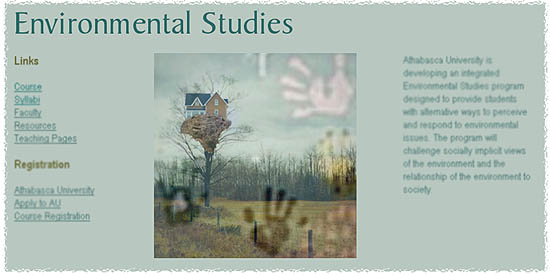
Take an early bird peek at one of AU’s new courses, Environmental Change in A Global Context (ENVS 243)! This course, which is also cross-listed as GLST 243, is tentatively scheduled to officially open to student registration within the next few weeks. Through an exciting blend of written and online media, ENVS 243 enables students to explore the myriad ways in which humans and their environment connect, and the effects of these interactions.
Unit 1 of ENVS 243 focuses on the currently debated topic of global climate change. Students explore the meaning of the words ?global ecosystem,? and are introduced to basic concepts related to current sustainability issues, ecological conservation, and restoration.
Units 2 and 3 focus on the atmosphere, including the ozone layer, surrounding our planet. Students learn about the atmospheric effects of the carbon and nitrogen cycles, and the effects of pollutants on the ozone layer. In addition, oceanic influences, including currents and temperature moderation, are discussed in relation to their direct and indirect effects on the atmosphere.
In unit 4, the main focus is greenhouse gases and their effects on global climate change. Through the course materials and readings, students learn about effects of a warming Arctic, and other environmental effects related to global warming. The Kyoto protocol is also discussed.
ENVS 243’s unit 5 focuses on biodiversity loss as a result of human interactions with the environment. Students have the opportunity to learn about the biodiversity index, and also hot spots of alarming decreases in species diversity. Students also explore issues related to species extinction and the implications of extinction.
During units 6 and 7, students are introduced to concepts related to energy and agriculture, and their effects on both the climate and the environment at large. This includes learning about the negative environmental effects of the petroleum industry, as well as discussing positive renewable energy options, including wind and solar power. Agricultural ecosystem topics include the effects of erosion and desertification, as well as current ideas in agriculture, such as permaculture. As well, students are introduced to the genetic engineering debate, with specific focus on its environmental impacts both for this generation and the next.
Unit 8 discusses the important topic of respect for ecological limits. Students are introduced to the concept of the ecological footprint and to natural capitalism solutions.
ENVS 243’s final topic focuses on an important environmental issue: sustainable development. Students explore why sustainable development is so important for the future health of our planet. Sustainable development guides, such as those from the Brundtland commission, are also discussed.
In addition to the student and study manuals for the course, ENVS 243 also has an exciting online component using its course home page. Students have access to a wide variety of internet links and other resources related to the different topics and sections discussed in each unit. These resources include articles from the EPA, WWF, and Environment Canada. Not only can these resources further a student’s learning experience in environmental science, but the ideas in these resources can help students decide on essay or assignment topics.
Environmental Science course coordinator Dr. Lorelei Hanson also tutors ENVS 252 (The Environment: Issues and Options for Action) and ENVS 435 (Case Studies in Environmental Protection). Her research interests include ?environmental history and the sociology of agriculture; land trusts; rural land management and conservation in Canada? (1). In addition, she has research focus on topics dealing with sustainability in the rural environment, and the various ecological relationships seen in such an environment.
Student evaluation in ENVS 243 consists of four assignments. Three of these assignments are tutor-marked exercises, worth 15%, 15%, and 20% respectively. The fourth assignment consists of a major essay, written on a self-chosen topic that is related to the material covered in the course. The essay has two components: first, a proposal outlining the student’s chosen topic and methods of approaching this topic in an essay format; and, finally, the essay component itself. The proposal is sent to the tutor for comments or suggestions prior to the writing of the essay, and it is marked on a pass/fail basis. The essay itself is worth 30% of the ENVS 243 course mark. The remaining 20% of the course evaluation is through a cumulative final exam.
For more information, visit the course syllabus at http://www.athabascau.ca/html/syllabi/envs/envs243.htm
(1) Athabasca University Centre for Global and Social Analysis. ?Environmental Studies Coordinators and Tutors.? http://envs.athabascau.ca/faculty.htm


